





Your deck or patio will fulfill your expectations with careful planning. Thorough planning means setting clear goals, establishing a budget, being familiar with the construction process, and making informed decisions that keep the project running smoothly.
continue reading below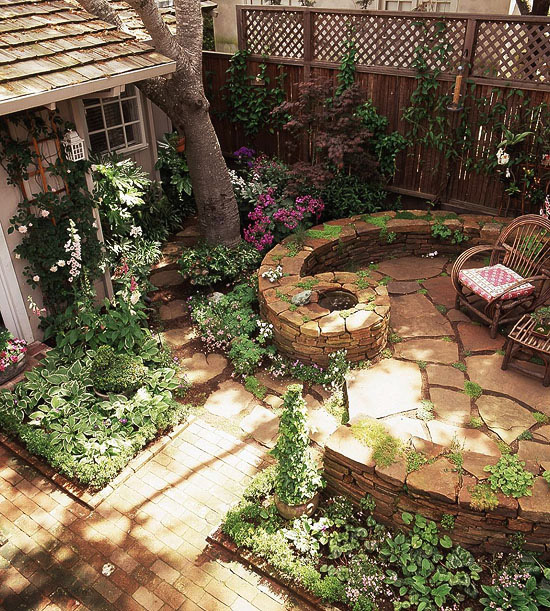 Creating areas with distinct
personalities makes this small
backyard patio seem larger.
Creating areas with distinct
personalities makes this small
backyard patio seem larger.
Planning proceeds in stages. Set primary goals by determining how you'll use the space and how elaborate the finished space will be. The more precise your goals, the more satisfactory the results. For example, increasing your outdoor living space is a good objective, but if you specifically envision quiet get-togethers for two or three close friends, you might be happy with an intimate deck or patio that features room for a table and a few chairs. If you prefer expansive parties for 20 or more, plan a deck or patio large enough for two or three good-size tables and even outdoor cooking and clean-up areas.
Make sure your project is architecturally compatible with the exterior of your home and the surrounding landscape. Consider hiring a professional such as an architect, landscape architect, or designer. A professional will help express your ideas on paper and will ensure the project is structurally sound and meets local codes, covenants, and setback distances. A qualified architect or designer can help reduce overall costs by anticipating problems and offering creative solutions before work begins.
Creating different levels and areas gives your design flexibility. For a small group, you can confine your activities to one portion or level of your deck or patio. If larger gatherings are expected, you can expand to other areas. You don't need to have a large deck or patio to achieve a flexible design. Use planters, furnishings, or overhead structures such as pergolas or arbors to create and define components of your overall living area.
As you plan, keep in mind which conveniences would be appropriate. Including several electrical outlets, for example, makes it easy to add or move pole and table lamps, hook up a portable stereo, or plug in a laptop computer.
 Patterns of shade in late
afternoon and evening are
especially important because
that's usually when it's time
to relax or entertain.
Patterns of shade in late
afternoon and evening are
especially important because
that's usually when it's time
to relax or entertain.
Begin planning by making sketches. The sketches record your thoughts, work out the scale and proportion of various design ideas, and visualize details. The most important reason to make sketches is to communicate your ideas to architects, builders, and other professionals who are part of your project team.
There is no need to make perfect drawings. It's important to use sketches as a way to make sure all design considerations -- such as traffic patterns and the location of significant landscape features -- are integrated into the final plan. Keep all of your sketches on file so you can see how your design ideas evolved.
Sketches showing a view from above are known as plan views. Plan views account for the arrangement of space, clearances between furnishings, traffic patterns, and the relationship of a deck or patio to the surrounding yard and environment.
Sketches showing views from the side or front are called elevations. Elevations give a sense of scale and help refine the design of vertical elements such as railings and privacy fences.
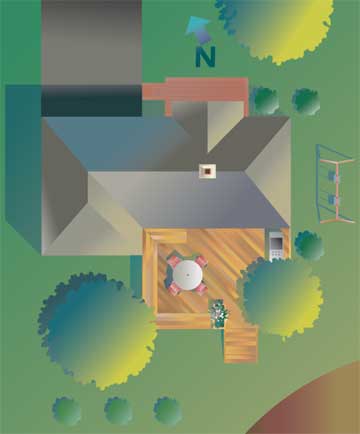 Based on shade patterns, this deck
will be placed to receive evening
shade from a backyard oak tree.
Based on shade patterns, this deck
will be placed to receive evening
shade from a backyard oak tree.
A good place to start making sketches is with a plat of your property. A plat is a plan view that shows the size and shape of your lot. Setbacks and easements also are shown.
Copy your plat onto graph paper. Indicate the position and footprint of your house and any ancillary structures, such as a garage or shed. Indicate which direction is north, and sketch in any major landscaping features, such as trees or a garden area. For trees, draw in the approximate trunk diameter, then lightly indicate the outer edges of the foliage. With trees placed, add the shade patterns for the time of day you are most likely to use your deck. At this point, you might want to make photocopies of this basic map. If you change your plans or want to compare different ideas, you can easily start fresh with a new basic map.
Decks and patios are transitional spaces that blend indoor rooms with outside environments. Significant landscaping features, such as trees and existing gardens, should be carefully integrated into your plans. When planning, remember these key points:
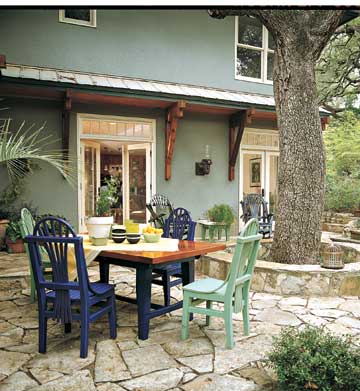 A large tree didn't deter plans
for this patio -- the homeowners
made it a key element of
design.
A large tree didn't deter plans
for this patio -- the homeowners
made it a key element of
design.
Trees are major features of well-planned outdoor rooms. They provide shade, privacy, and natural focal points. Make every effort to incorporate existing trees into your design. You can add trees, but the cost of installing a tree large enough to provide shade -- one with a trunk that is 3 to 6 inches in diameter -- can be $500 to $1,000. Large trees might be right in the middle of your proposed deck or patio area. With a little ingenuity, you can build around them. Having a large shade tree growing through the middle of a deck creates a delightful natural overhead shade structure for your new outdoor space.
Fast-growing vines are another way to provide shade and privacy. To take advantage of a vine, you'll need to plan a trellis for the vines to climb and you'll want the trellis structure to be integral to the overall design of your deck or patio. In the right conditions, a vine will grow 15 to 20 feet in a single season and provide plenty of leafy greenery by midsummer. Fast-climbing flowering vines, such as trumpet vines and clematis, offer shade and sprays of beautiful flowers throughout the warmest months.
Foundation plantings can be important additions to your project, especially if you have a raised deck. Sturdy foundation plantings grow 2 to 4 feet high and help disguise footings, posts, and other structural components that might otherwise be exposed to view. When choosing foundation plantings, consider the amount of sunlight that will be available for your plants after the project is complete. Certain portions of your deck or patio might be in full shade for most of the day, for example, and you'll want to make sure to select plants that will thrive without much sun.
To protect existing plants during construction, tell your building contractor to use every caution when installing footings for a deck or restructuring a sloped yard with retaining walls. A plant's root structure can be damaged during digging or by the pressure of heavy equipment moving over the ground. To prevent injury to trees, experts recommend building no closer than the tree's drip line -- the outer edge of its foliage. Digging a few holes for foundation footings usually won't destroy a mature tree. Reduce possible root damage by designing a minimum of footings or using cantilevers that project your deck toward valuable trees and shrubs without using footings. To build a code-compliant cantilever, consult an architect or registered structural engineer.
Moving a favorite tree out of the way is an option. For $100 to $200, existing trees up to 6 inches in diameter can be transplanted by a tree service that has a truck-mounted tree spade. Look in the Yellow Pages of your telephone directory under "Tree Service" and "Landscape Contractors." For more information specific to your locality and type of tree, contact an arborist at your state university's agricultural department, or call your state's department of agriculture or county extension service -- if they have the time, they'll provide free advice.
For a fee, you can contract the services of a design professional who specializes in landscaping. A professional will make a map of your property, integrate your project ideas, and produce a plan that is as extensive as you'd like. Some landscape contractors combine design and installation services, although they might lack professional certification. Expect to pay $2,000 to $6,000 for a plan and installation of landscaping features for an average-sized suburban house that include new borders, plantings, a 10 x 16 brick patio, and paths.
It's important to establish visual harmony between your new deck or patio and the existing house. Compatibility should include the size and shape of the house, the types of materials used, and the scale and placement of stairs, railings, arbors, screens, and other elements. The best designs integrate key features with the size of the yard and existing plantings.
Although each piece of property is unique, creating harmony follows several commonsense rules of good design:
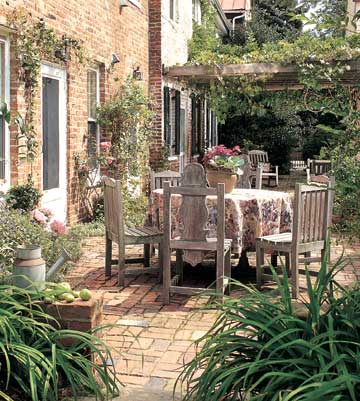 This simple brick patio is
perfectly sized for its
surroundings and planned use.
This simple brick patio is
perfectly sized for its
surroundings and planned use.
Take cues from the existing house. You don't have to reproduce elements precisely, but structural elements such as posts and railings should be thoughtfully selected and blend well with the overall design of the house. A low platform deck, for example, fits well with the shape and scale of a single-story ranch-style home. However, such a simple deck design would be out of place attached to a larger, ornate Victorian house. For that, you'd probably want to add posts and railings that complement decorative details from cornices or window trim, and possibly paint new elements to match existing woodwork.
Don't introduce new materials that are radically different from what already exists. A two-story brick home suggests using brick pavers for a patio, rather than elaborate stonework or plain concrete. When you mix textures and colors, be sure to add elements of the original. That plain concrete patio at the back of the two-story brick home will look a lot better if the concrete is tinted or stained to match the brick, or if it is surrounded by a border made of brick.
Scale is important. Don't get carried away and design a deck or patio that threatens to overwhelm the original house. Even if money is no object and you imagine the grandest of deck/patio combinations, the final design should be carefully scaled so that it is in proportion to the main house. Sketching different possibilities on paper helps you to visualize changes and to experiment with proportions. Even if you plan to hire a design professional, your own sketches are also a good way to start a productive dialogue about your preferences.
It's exciting to imagine the ways your new deck or patio will change your outdoor environment, but it's just as important to remember how your project will change the use of adjacent interior spaces. New doorway locations and altered traffic patterns are a few of the possible consequences. If your new deck or patio is part of a more expansive renovation plan, make sure the traffic flows easily from one space to the other, and that the changes meet your goals for comfort and livability.
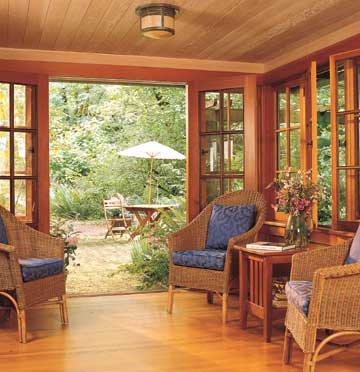 French doors let this airy,
four-season entry room open
directly to the backyard patio.
French doors let this airy,
four-season entry room open
directly to the backyard patio.
Kitchens and family rooms are good transition points for accessing a deck or patio. These areas usually are less formal and are natural places for kids and pets to wander in and out of the house. Wear-resistant vinyl or tile flooring stand up to traffic well and are easy to clean.
Having a door leading from a kitchen to a deck or patio provides easy access when entertaining. If you have a standard exterior door in this location, consider changing it to a sliding patio or a double French doorway for a larger opening and to expose interior rooms to views and light. Plan on spending $2,000 to $3,000 for a contractor to install a 6-foot-wide, sliding patio door, including all materials.
As you plan, sketch in traffic patterns from access doorways to deck or patio stairs and paths. These traffic patterns should be sensible and practical. Keep tables and eating areas well away from traffic. If possible, place grills and cooking equipment in out-of-the-way locations or in special niches built just for them. Leave plenty of legroom in front of built-in benches so that guests won't have to retract their legs every time someone walks past.
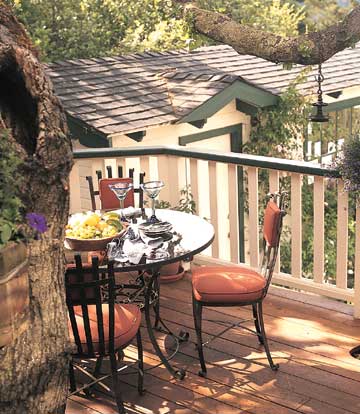 A second-story deck is set amid
the treetops and stays shady
almost all day.
A second-story deck is set amid
the treetops and stays shady
almost all day.
A professional designer creates a space that meets your needs. Because of their expertise and experience, professionals can offer fresh ideas, anticipate code restrictions, and deal with unusual problems. If the cost of hiring a designer seems prohibitive, consider that professionals can help save on overall costs by contributing to the efficiency of the project, by organizing and managing work flow, and by helping to avoid expensive mistakes. Many of them are willing to work as consultants for an hourly fee.
When working with a professional, good communication is key to achieving your goals. Start a clipping folder. Use it to keep articles and photographs cut from magazines that show ideas and design elements that appeal to you. Add product brochures or advertisements that you can show to your designer. Draw sketches of your ideas, and share them with your designer. A good designer is interested in your lifestyle and should ask questions and take notes about how you live, your daily routine, and your project goals.
Three types of design professionals can work on a deck or patio project. Although they have specialized areas of expertise, most professionals are well-versed in all phases of design and can help create a comprehensive plan.
Architects work primarily with structure and reorganization of space. They are familiar with many types of building materials, finishes, and structural systems. An architect is a good choice for complex deck designs. An architect will design your deck and make sure it is sensibly integrated with adjacent living areas, such as your kitchen or family room. Architects charge a percentage of the project's total cost, usually 10 to 15 percent. If hired on an hourly basis, they charge $50 to $125 per hour. For a listing of architects in your area, look in the Yellow Pages of your phone directory, or try the Internet search engine offered by the American Institute of Architects.
American Institute of Architects
Landscape architects registered with the American Society of Landscape Architects (ASLA) are usually designers only; the plans they furnish must be given to a landscape contractor for final installation. Occasionally, a professional landscape architect joins with a landscape contractor to offer full-service planning and installation. An ASLA architect will charge $75 to $125 per hour to inspect and analyze the property, and then complete detailed drawings that recommend plantings and landscape features which help connect the new space to the outdoor environment. To create a plan, expect to pay 15 percent of the cost of the finished landscape project. To find a landscape architect, consult the Yellow Pages of your telephone directory under "Landscape Architects," or check with the American Society of Landscape Architects.
American Society of Landscape Architects
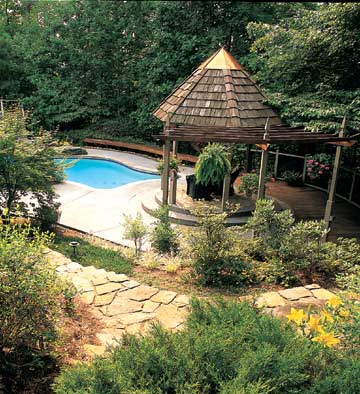 An architect's design is evident
in this complex arrangement of
outdoor spaces.
An architect's design is evident
in this complex arrangement of
outdoor spaces.
Landscape contractors can install decks, patios, walkways, retaining walls, plantings, and ancillary structures such as pergolas and arbors. Many landscape contractors are full-service business firms that have landscape architects, designers, and installers, and can provide a full range of services that include initial concepts, finalized plans, installation, and ongoing maintenance. If required by state law, a landscape contracting company should be licensed or certified, indicating they have passed examinations and have demonstrated expertise and knowledge, and that they participate in ongoing programs of education. Find "Landscape Contractors" in the Yellow Pages of your telephone directory or contact the Associated Landscape Contractors of America.
Associated Landscape Contractors of America
 Installing your own low-voltage
lighting will require some basic
wiring skills.
Installing your own low-voltage
lighting will require some basic
wiring skills.
Careful planning of your electrical needs helps ensure your satisfaction when the project is complete. If you plan to use your new porch or sunroom as a supplemental kitchen, you might need individual circuits to run small appliances such as cooktops and rotisseries.
A few electrical outlets ensures you'll be able to plug in stereo equipment, supplemental lamps, or a laptop computer. Calculate your home's existing power requirements to determine if you'll need additional circuits to handle the increased load. A licensed electrical contractor can make these calculations and ensure your project conforms to the specifications set forth by the National Electrical Code (NEC®). A modest deck or patio usually can be serviced by splicing into an existing circuit. More extensive remodeling could require adding a circuit. Your design professional or general contractor should be able to provide a cost estimate for electrical work. If you are acting as your own general contractor, take bids from several electrical contractors to establish a price for the work.
Splicing into an existing circuit requires an electrician to locate an existing junction box to add wiring, or else add a junction box at some point along a length of existing wiring. Junction boxes often are located in open attic or basement spaces where they are readily accessible. Occasionally, an electrician must open up walls and ceilings to access wiring and add new junction boxes -- work that requires minor demolition. The cost of repairing walls and ceilings will be part of the cost of the project.
Outdoor receptacles should be placed in weatherproof boxes with spring-loaded outlet covers that seal against moisture. Also, most building codes require that outdoor receptacles be protected by a ground-fault circuit interrupter (GFCI). If there is a short circuit, GFCI-type receptacles detect the deviation in current and instantly shut off power to the receptacle.
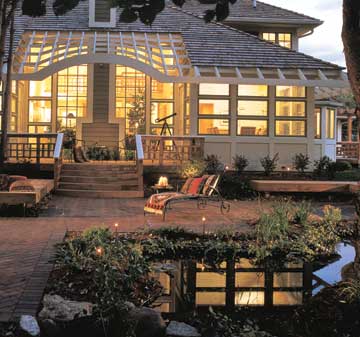 Small, low-voltage lights offer
minimal illumination, but they
enhance safety by defining the
pond wall perimeter.
Small, low-voltage lights offer
minimal illumination, but they
enhance safety by defining the
pond wall perimeter.
A well-designed outdoor lighting system allows you to use your deck or patio in comfort and safety during the evening. It should illuminate key points, such as conversation areas, cooking centers, doors, walkways, pool surrounds, and stairs. It also can be used to highlight special features, such as plants or trees, and can provide security lighting around foundation plantings and fences.
Outdoor lighting comes in three types: regular fixtures that use 120-volt household current, low-voltage, and solar-powered. Low-voltage lighting is increasingly popular because it is safe, inexpensive, and easy to install. Manufacturers of low-voltage lighting offer an array of styles and configurations made especially for outdoor residential use that are readily available at home improvement centers. Both the low-voltage and solar lights are either freestanding units or fasten to posts, railings, stair risers, and other components.
Lamps, or bulbs, cast different kinds of light. The familiar incandescent bulbs are relatively inexpensive. They have a warm, natural quality of light that is especially pleasing on faces. These lights can be dimmed with rheostat switches -- a real advantage for design flexibility. Quartz-type incandescent lamps provide a more intense "whiter" light.
High-intensity discharge (HID) lamps include metal halide, mercury vapor, and high-pressure sodium lamps. All provide reliable, brilliant light and are especially energy-efficient, but they are not recommended for use with dimmer switches. Some people are bothered by the orange or greenish cast of the light from HID lamps. They are used primarily for safety lighting around pools, or for illuminating large activity areas, such as tennis courts.
When planning a lighting scheme, keep the design as flexible as possible so that your lighting is appropriate for a variety of uses. Use several circuits, and plan for dimmer switches that allow you to control the amount of light in individual areas. Place switches indoors.
If you also want switches outdoors, you'll need to have 3-way switches installed. To avoid annoying glare, make sure the light source -- the bulb -- is hidden from direct view by using shades, covers, or plantings, or by letting light bounce off large reflective surfaces such as walls.
An outdoor lighting system usually is a combination of several lighting techniques. The most common types are:
Light the Night
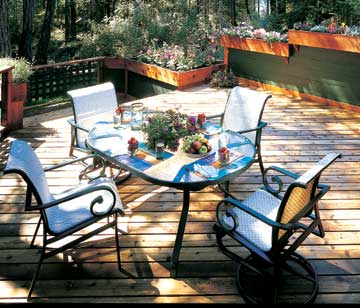 An imaginative railing system
featuring built-in, latticed
flower boxes is right at home
in this woodsy setting.
An imaginative railing system
featuring built-in, latticed
flower boxes is right at home
in this woodsy setting.
A workable budget usually is a compromise between all the great things you imagine for your finished project and what you ought to budget to achieve your goals. Your first priority should be to set limits for the total amount of money you'll spend. As a guide, make two lists. One list should include everything you consider essential for your new space. The other list should be the extras -- the amenities you'd like to have if there's money left over after you pay for essentials. Don't add extras until costs for the essentials are finalized.
As you complete your ideas and move toward construction, you'll need to get bids from contractors and other professionals. Add a 5- to 10-percent "cushion" to the total figure to cover cost overruns and changes to plans that can occur after construction has begun. Have a firm idea of what you'd like to spend and tell it to all of the professionals involved in your project. A commitment to your bottom line will help you make the difficult cost-cutting decisions if your project threatens to go over budget.
Copyright © www.100flowers.win Botanic Garden All Rights Reserved